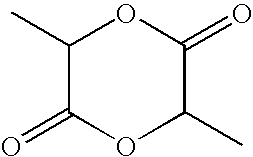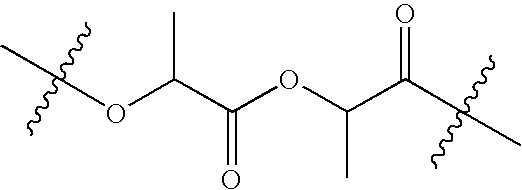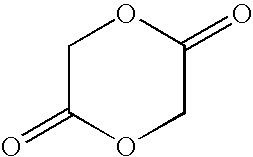Novel sustained release polymer
- Summary
- Abstract
- Description
- Claims
- Application Information
AI Technical Summary
Benefits of technology
Problems solved by technology
Method used
Image
Examples
example 1
Preparation of Polymer
General Procedure
[0076]In a jacketed stainless steel polymerization vessel, appropriate amounts of lactide and glycolide are added and the vessel contents are placed under a nitrogen atmosphere. The temperature of the vessel is increased until the reagents melt. An appropriate amount of an alkanediol is then added, followed by addition of stannous octanoate catalyst. The vessel is then heated at about 135-145° C. under nitrogen atmosphere for about 3-4 hours with constant stirring. Then, to remove unreacted lactide and glycolide monomers, the vessel is evacuated and the monomers are vacuum distilled out of the polymerization mixture. The hot melt is then extruded into cooling pans. After cooling, the solid mass is cryo-ground to a fine powder and dried.
example 2
Preparation of a Leuprolide Acetate Controlled Release Formulation
[0077]A sample of a controlled release formulation for use as a subcutaneous depot was prepared from a polymer prepared as described in Example 1, with a 75 / 25 lactide to glycolide weight ratio. The polymer and N-methylpyrrolidone were mixed in a 45 / 55 weight ration until the polymer was completely dissolved in the solvent, then the polymer solution was further mixed with leuprolide acetate to provide a formulation wherein 0.375 gm (about 0.37 mL) of the flowable composition contained 22.5 mg of leuprolide acetate. The mixing was carried out by placing the polymer solution in one syringe, the leuprolide acetate as a lyophilized solid in a second syringe, connecting the two syringes with a luer-lock type connector, and exchanging the contents of the syringes. The solution, a flowable composition, was of sufficient liquidity to be transferred into a patient through a ⅝ inch 20 gauge syringe needle.
example 3
Treatment of Prostate Cancer Patients with Leuprolide Controlled Release Formulation Comprising Polymer of the Present Invention
[0078]The solution of Example 2 was injected into the upper right or left abdominal quadrants of 117 patients, 0.37 mL per patient, the patients being afflicted with prostate cancer not previously treated to reduce serum testosterone levels. A depot volume of 0.37 mL was delivered in each case to provide a total of 22.5 mg leuprolide acetate over the period of release. Blood samples were collected and analyzed for testosterone and leutinizing hormone (LH). From a baseline level of about 400-600 ng / dL, testosterone levels dropped to below 20 ng / dL by about day 20 and remained at that level until day 84, when a second depot was injected. Serum testosterone levels were observed to continue to be maintained at or below 20 ng / dL until the end of the study at 168 days. Similarly, LH levels dropped from a pre-treatment baseline of about 10 mIU / mL to below 1 mIU / mL...
PUM
| Property | Measurement | Unit |
|---|---|---|
| Temperature | aaaaa | aaaaa |
| Fraction | aaaaa | aaaaa |
| Fraction | aaaaa | aaaaa |
Abstract
Description
Claims
Application Information
 Login to View More
Login to View More - R&D
- Intellectual Property
- Life Sciences
- Materials
- Tech Scout
- Unparalleled Data Quality
- Higher Quality Content
- 60% Fewer Hallucinations
Browse by: Latest US Patents, China's latest patents, Technical Efficacy Thesaurus, Application Domain, Technology Topic, Popular Technical Reports.
© 2025 PatSnap. All rights reserved.Legal|Privacy policy|Modern Slavery Act Transparency Statement|Sitemap|About US| Contact US: help@patsnap.com



